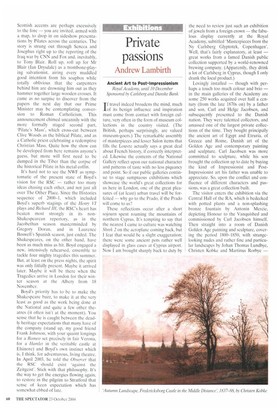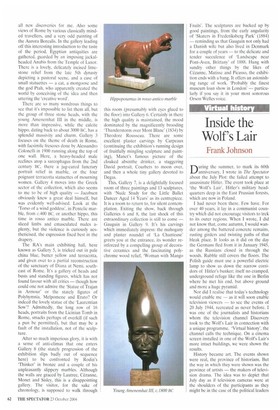Private passions
Andrew Lambirth
Ancient Art to Post-Impressionism Royal Academy, until 10 December Sponsored by Carlsberg and Danske Bank Scottish accents are perhaps excessively to the fore — you are invited, armed with a map, to drop in on sideshow presentations by Pilates across the centuries. The story is strung out through Seneca and Josephus right up to the reporting of the Iraq war by CNN and Fox and, inevitably, to Tony Blair. Roll up, roll up for Mr Blair (Ian Drysdale) as a trombone-playing salvationist, airing every muddled good intention from his soapbox while totally oblivious that the carpenters behind him are drowning him out as they hammer together large wooden crosses. It came as no surpisc to discover from the papers the next day that our Prime Minister may be contemplating conversion to Roman Catholicism. This announcement chimed uncannily with the more formally staged second part, Pilate's Mass', which cross-cut between Clive Woods as the biblical Pilate, and as a Catholic priest celebrating a redemptive Christian Mass. Quite how the show can be developed from here remains anyone's guess, but more will first need to be dumped in the Tiber than the corpse of the historical Pilate in his metal coffin.
It's hard not to see the NWF as symptomatic of the present state of Boyd's vision for the RSC — rather too many ideas chasing each other, and not just all over The Other Place. Since the Histories sequence of 2000-1, which included Boyd's superb stagings of the Henry VI plays and Richard III, the RSC's heart has beaten most strongly in its nonShakespearean repertory, as in the Jacobethan season masterminded by Gregory Doran, and in Laurence Boswell's Spanish season, just ended. The Shakespeares. on the other hand, have been as much miss as hit. Boyd engaged a new, intensively rehearsed, ensemble to tackle four mighty tragedies this summer. But, at least on the press nights, the spirit was only fitfully present. Maybe it arrived later. Maybe it will be there when the Tragedies arrive in London for their winter season at the Albery from 18 November.
Boyd's priority has to be to make the Shakespeare buzz, to make it at the very least as good as the work being done at the National and quite a few other theatres (it often isn't at the moment). You sense that he is caught between the deadly heritage expectations that many have of the company (stand up, my good friend Frank Johnson, with your quaint longings for a Romeo set precisely in fair Verona, for a Hamlet in the veritable castle at Elsinore) and Boyd's own instinct which is, I think, for adventurous, living theatre. In April 2003, he told the Observer that the RSC should exist 'against the Zeitgeist'. Stick with that philosophy. It's the way to get the energies flowing again, to restore in the pilgrim to Stratford that sense of keen expectation which has somewhat ebbed of late. I f travel indeed broadens the mind, much of its benign influence and inspiration must come from contact with foreign culture, very often in the form of museum collections in the country visited. (The British, perhaps surprisingly, are valued museum-goers.) The remarkable assembly of masterpieces and lesser Salon items that fills the Louvre actually says a great deal about French history, if correctly interpreted. Likewise the contents of the National Gallery reflect upon our national character and patterns of taste with no less piquancy and point. So if our public galleries continue to stage sumptuous exhibitions which showcase the world's great collections for us here in London, one of the great pleasures of (at least) urban travel will be forfeited — why go to the Prado, if the Prado will come to us?
These reflections occur after a short sojourn spent roaming the mountains of northern Cyprus. It's tempting to say that the nearest I came to culture was watching S'hrek 2 on the aeroplane coming back, but I fear that would be a slight exaggeration; there were some ancient pots rather well displayed in glass cases at Cyprus airport. Now I am brought sharply back to duty by
the need to review just such an exhibition of jewels from a foreign crown — the fabulous display currently at the Royal Academy, subtitled 'Masterpieces from the Ny Carlsberg Glyptotek, Copenhagen'. Well, that's fairly explanatory, at least — great works from a famed Danish public collection supported by a world-renowned brewing company. (Apparently, they drink a lot of Carlsberg in Cyprus, though I only drank the local product.) Lovingly installed — though with perhaps a touch too much colour and brio — in the main galleries of the Academy are some 250 works acquired over half a century (from the late 1870s on) by a father and son, Carl and Help Jacobsen, and subsequently presented to the Danish nation. They were talented collectors, and amassed one of the largest private collections of the time. They bought principally the ancient art of Egypt and Etruria, of Greece and Rome, Danish art of the Golden Age and contemporary painting and sculpture. Carl Jacobsen was more committed to sculpture, while his son brought the collection up to date by buying the kind of Impressionist and PostImpressionist art his father was unable to appreciate. So, upon the conflict and confluence of different characters and passions, was a great collection built.
The visitor enters the exhibition via the Central Hall of the RA, which is bedecked with potted plants and a non-splashing bronze fountain by Antonin Mercie, depicting Honour to the Vanquished and commissioned by Carl Jacobsen himself. Then straight into a room of Danish Golden Age painting and sculpture, covering the period 1800-1850, with strangelooking nudes and rather fine and particular landscapes by Johan Thomas Lundbye, Christen Kobke and Martinus Rorbye —
all new discoveries for me. Also some views of Rome by various classically minded travellers, and a very odd painting of the Aurora Borealis. In the gallery leading off this interesting introduction to the taste of the period, Egyptian antiquities are gathered, guarded by an imposing jackalheaded Anubis from the Temple of Luxor. There is a lovely, delicately incised limestone relief from the late 5th dynasty depicting a pastoral scene, and a case of small statuettes — a cat, a mongoose and the god Ptah, who apparently created the world by conceiving of the idea and then uttering the 'creative word'.
There are so many wondrous things to see that it's impossible to list them all, but the group of three stone heads, with the young Amenemhat III in the middle, is more than impressive, while the calcite hippo, dating back to about 3000 BC, has a splendid massivity and charm. Gallery 3 focuses on the theme of death in Rome, with facsimile frescoes done by Alessandro Colonelli in 1900 running along the top of one wall. Here, a heavy-headed male reclines atop a sarcophagus from the 2nd century BC, there a jug-eared funerary portrait relief in marble, or the four poignant terracotta statuettes of mourning women. Gallery 4 moves into the Greek sector of the collection, which also seems to me to be of high quality — Jacobsen obviously knew a great deal himself, but was evidently well-advised. Look at the 'Torso of a wind goddess', in Pentelic marble, from c.400 BC, or another hippo, this time in rosso antic° marble. There are sliced limbs and emasculated nudes aplenty, but the violence is curiously aestheticised, the expression fixed best in the drapery.
The RA's main exhibiting hall, here known as Gallery 5, is tricked out in pale china blue, butter yellow and terracotta, and given over to a partial reconstruction of the sanctuary of Diana at Nemi, southeast of Rome. It's a gallery of heads and busts and standing figures, which has not found favour with all critics — though how could one not admire the 'Statue of Trajan in Armour' or the stately figures of Polyhymnia. Melpomene and Erato? Or indeed the lovely statue of the 'Laurentian Sow'? Admittedly, the long row of 16 heads, portraits from the Licinian Tomb in Rome, smacks perhaps of overkill (if such a pun be permitted), but that may be a fault of the installation, not of the sculpture.
After so much imperious glory, it is with a sense of anti-climax that one enters Gallery 8 (the stately progression of the exhibition slips badly out of sequence here) to be confronted by Rodin's 'Thinker' in bronze and a couple of his unpleasantly slippery marbles. Although the walls are graced by Lautrec, Cezanne, Monet and Sisley, this is a disappointing gallery. The visitor, for the sake of chronology, is supposed to walk through this room (presumably with eyes glued to the floor) into Gallery 6. Certainly in there the high quality is maintained, the mood dominated by the magnificently brooding 'Thunderstorm over Mont Blanc' (1834) by Theodore Rousseau. There are some excellent plaster carvings by Carpeaux (continuing the exhibition's running design of fruitfully mingling sculpture and painting), Manet's famous picture of the cloaked absinthe drinker, a staggering David portrait, Courbets to moon over, and then a whole tiny gallery devoted to Degas.
This, Gallery 7, is a delightfully focused room of three paintings and 13 sculptures, with 'Nude Study for the Little Ballet Dancer Aged 14 Years' as its centrepiece. It is a room to return to, for silent contemplation. Exiting the show, back through Galleries 6 and 8, the last shock of this extraordinary collection is still to come — Gauguin in Gallery 9. It's his carvings which immediately impress: the mahogany and plaster roundel of 'La Chanteuse' greets you at the entrance, its wonder reinforced by a compelling group of decorative ceramics and the fascinating polychrome wood relief, 'Woman with Mango Fruits'. The sculptures are backed up by good paintings, from the early angularity of 'Skaters in Frederiksberg Park' (1884) — reminding us that Gauguin not only had a Danish wife but also lived in Denmark for a couple of years — to the delicate and tender succulence of 'Landscape near Pont-Aven, Brittany' of 1888. Hung with sundry other things by the likes of Cezanne, Matisse and Picasso, the exhibition ends with a bang. It offers an astonishing range of work. 'Probably the finest museum loan show in London' — particularly if you say it in your most sonorous Orson Welles voice.

























































































 Previous page
Previous page